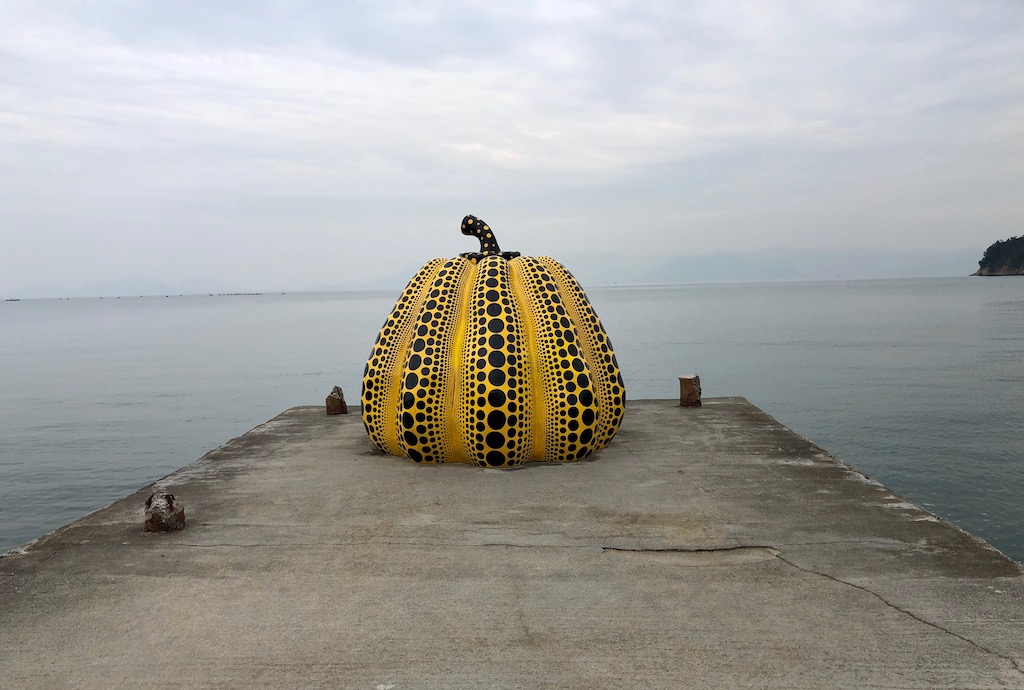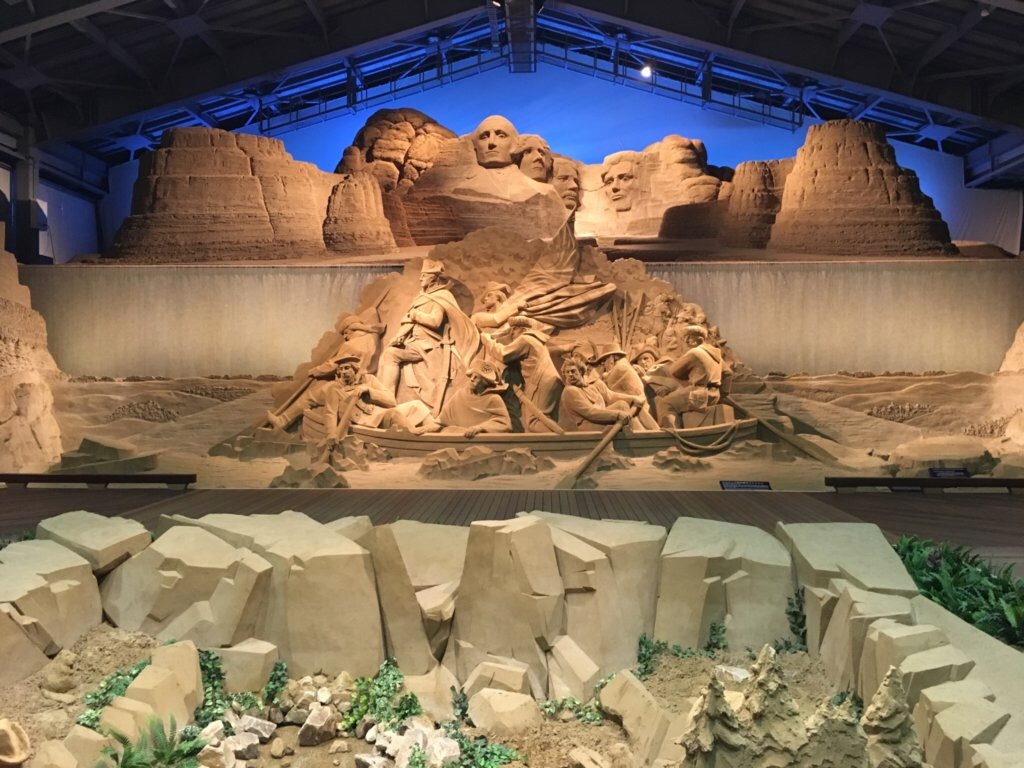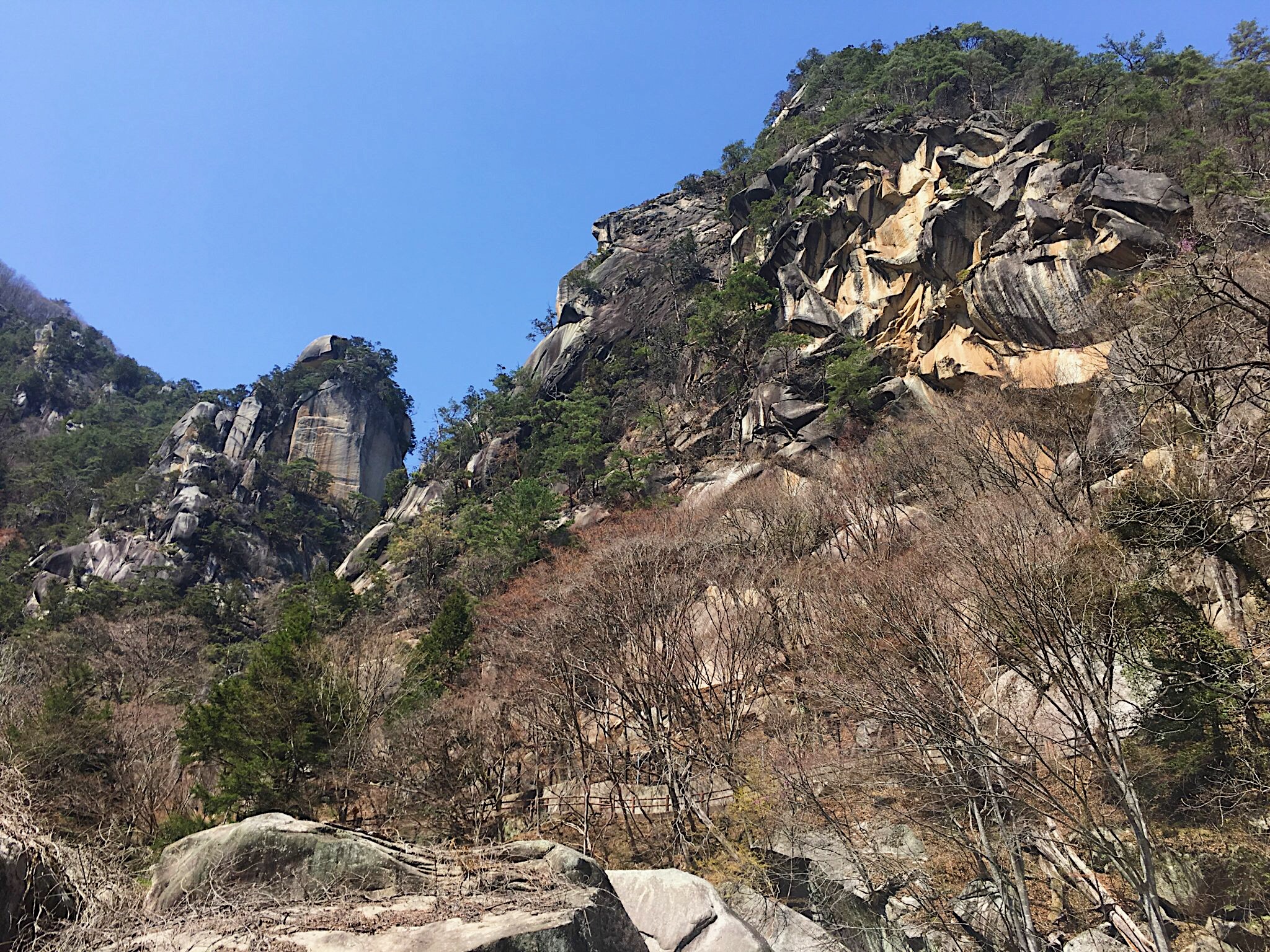I traveled to Naoshima, one of the islands in the Seto Inland Sea.
Naoshima is a small island in Kagawa Prefecture with a population of around 3000 people. There are many artworks on the island, including a polka dot pumpkin by avant-garde artist Yayoi Kusama. The island is also home to popular museums such as the Benesse House Museum.
There are many ways to get around Naoshima, including cars, bikes and motorbikes, but this time I decided to explore the island mainly on foot (and by bus).
The reason why we decided to go mainly on foot is that we just wanted to walk (don’t you sometimes feel like that?), for no particular reason.
I didn’t stop at any of the museums or restaurants in Naoshima as I went on a Monday when most of the facilities were closed. However, just walking around Naoshima is a great way to soak up the artistic atmosphere.
This article describes our half-day tour of Naoshima.
From Uno Port in Okayama Prefecture to Naoshima
Easy access to Naoshima
Let’s start with a boat trip to Naoshima.
There are two ports to Naoshima, Takamatsu Port in Kagawa Prefecture and Uno Port in Okayama Prefecture, each with daily boat services.
There are 10 daily departures from Takamatsu Port and 20 daily departures from Uno Port, making Naoshima an easy island to reach on a day trip.
A 15-minute journey from Uno Port to Naoshima
From the port of Uno in Okayama Prefecture, a passenger fast boat will take you to the port of Miyaura on Naoshima in 15 minutes (20 minutes by ferry).
The fare is 290 yen one way (return discount 560 yen) for both the ferry and the smaller passenger boats. Cars, bicycles and motorbikes can also be taken on the ferry for an additional charge.
Passing the islands of the Seto Inland Sea at breakneck speed
I parked my car in a car park near the port of Uno and set off on the 10am boat. Perhaps because it was a weekday Monday, the boat was only about a third full of passengers.
The boat passed by Kuzurajima and Koujinjima in the Seto Inland Sea and arrived at the port of Miyaura on Naoshima in no time at all.
It was November and although it was drizzling, the temperature was a balmy 17 degrees, just right for a walk.
Marine Station Naoshima
Get a guide map of Naoshima at the Tourist Information Centre
The first stop after arriving at Miyaura Port was “Marine Station Naoshima” right in front of the boat arrival terminal. The station has a tourist information centre where you can get a guide map of Naoshima.
If you want to plan your trip in advance, you can also download the same guide map and timetable from the Naoshima Tourist Association website.
Naoshima Travel Information (Guide Map Download)
These guide maps were very useful for me when planning my trip to Naoshima.
Naoshima’s three main tourist areas
The Naoshima Guide Map shows the following three areas as the main places to explore on Naoshima.
-
- The Miyanoura area around Miyanoura Port
- The Honmura area, with its house projects
- The museum area, with its many museums
Let’s walk around the Miyanoura area first, then take a bus to the Honmura area and the museum area, and finally walk back to the Miyanoura area. I’ ll also introduce the highlights of each area in brief.
Walking tour of the Miyanoura area (30 minutes)
The red pumpkin stands out from the rest.
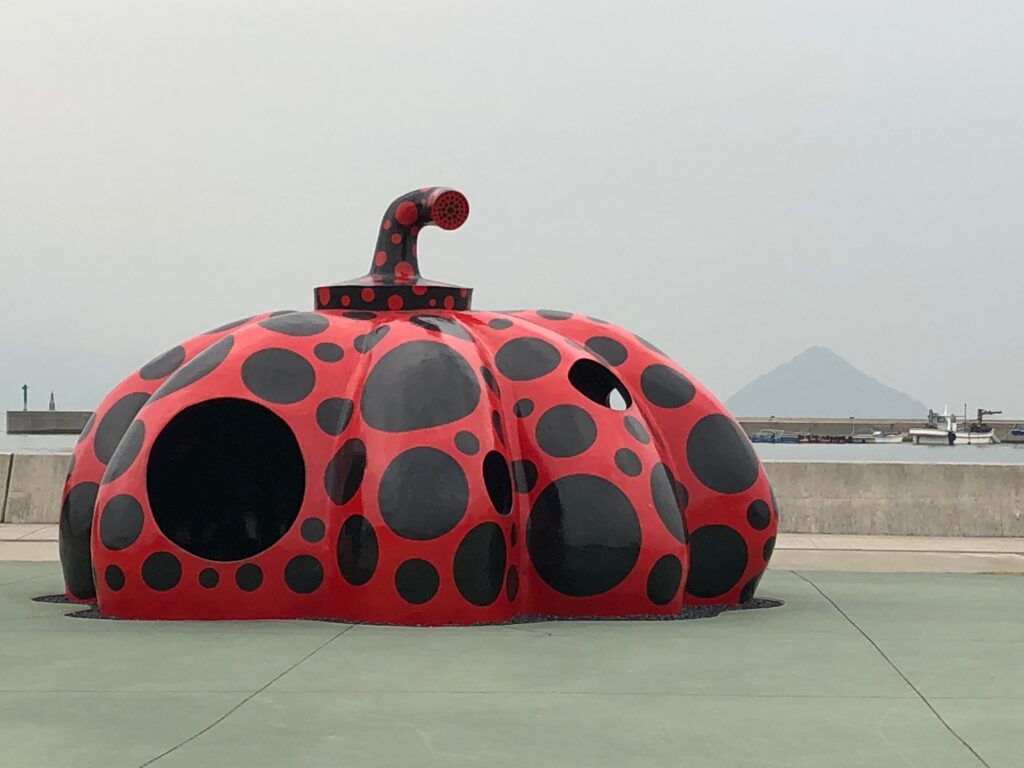
Let’s take a walk around the Miyanoura area.
Standing at the arrival terminal of the Miyanoura Port, the first thing you see is a “red pumpkin” sculpture in the square facing the sea. It is easily recognisable as a polka-dot work by Yayoi Kusama.
The Red Pumpkin stands out from a distance because it is so large and can hold more than 10 people. The inside of the object is painted black and there are many polka dots on the floor, reflected in the light from outside.
Ozuchijima, an uninhabited island in the Seto Inland Sea
The triangular island to the right of and behind the red pumpkin in the photo above is called Otsuchijima. This island is not on Google Maps, but if you walk along the coast of Naoshima you will sometimes see this triangular island.
Otsuchijima is an uninhabited island with a line down the middle, exactly half of which is in Kagawa Prefecture and the other half in Okayama Prefecture. There are many more inhabited and uninhabited islands in the Seto Inland Sea.
Naoshima Pavillion
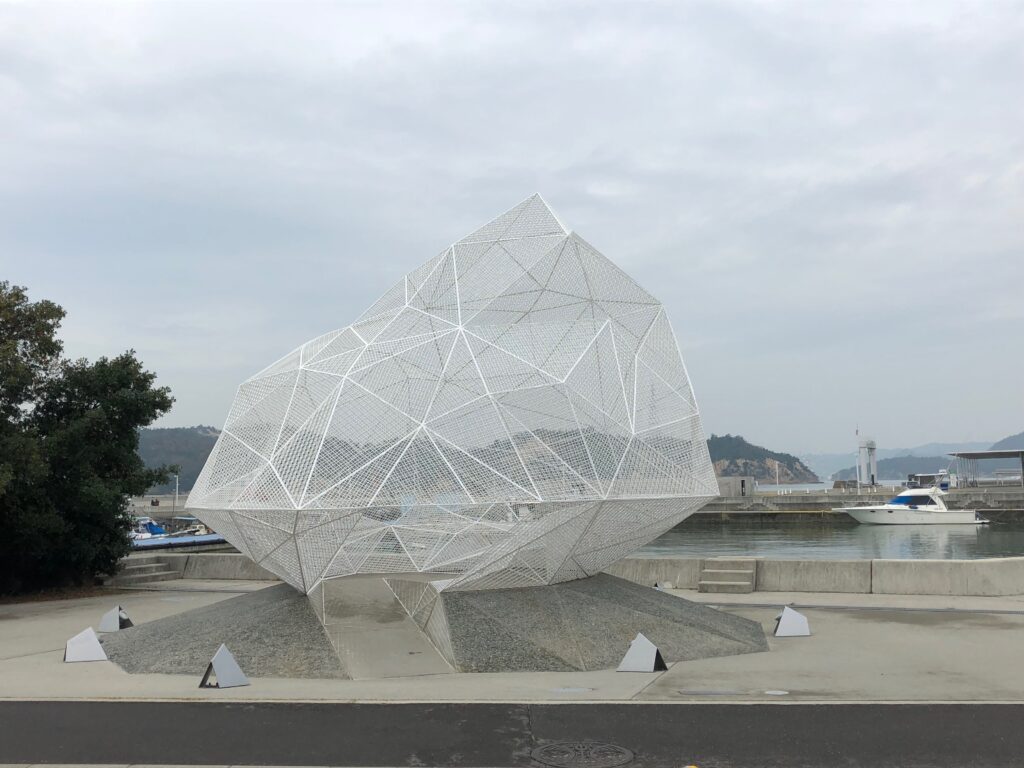
Three minutes’ walk from the Red Pumpkin, you will find a polygonal object. This beautiful white sculpture, made of stainless steel netting, is a new artwork on the island called “Naoshima Pavilion”. It was designed by an architect named Sousuke Fujimoto.
You can also enter and take photos inside the Naoshima Pavilion.
The Miyanoura area is a labyrinth
In addition to the artworks displayed outdoors, the Miyanoura area is lined with stylish cafés, restaurants and shops huddled together in houses. The passageways are so intricate that you will feel as if you are lost in a maze.
As we walked along we noticed a colourfully decorated building with the words “I🖤湯” on its exterior. This building is actually a public bath where you can take a bath.
Explore the Honmura area (40 minutes)
Take a public bus to the Honmura area (7 minutes)
Next, we will take a bus to Honmura area.
You can take the town bus from the Miyaura Port stop in front of the Umi no Eki Naoshima building to the Honmura area. The fare for the Naoshima town bus is a reasonable 100 yen per trip, no matter where you are on the island. After a 7 minute ride, we arrived at the Kimura Port stop.
In the Honmura area, we walked around the Honmura Port area to see an art facility called the House Project, private houses, cafes and the beach.
House Projects
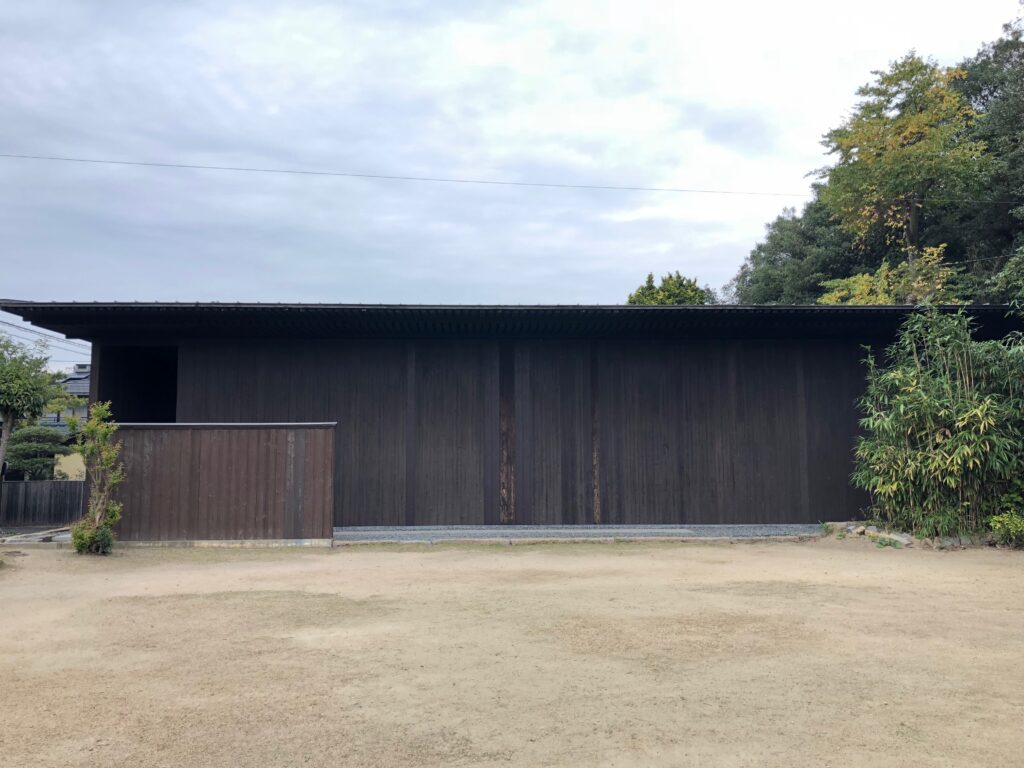
The Kimura area is dotted with “house projects”, interactive art galleries created by renovating abandoned private houses. This is the front of the wooden building of “Nanji”, one of the House Projects.
Nanji is home to the work of American contemporary artist James Turrell. The building was designed by Tadao Ando. I’ m curious to see what it looks like inside, but unfortunately it is all closed today, so I continue my walk around the town.
Instagrammable spots all over the town
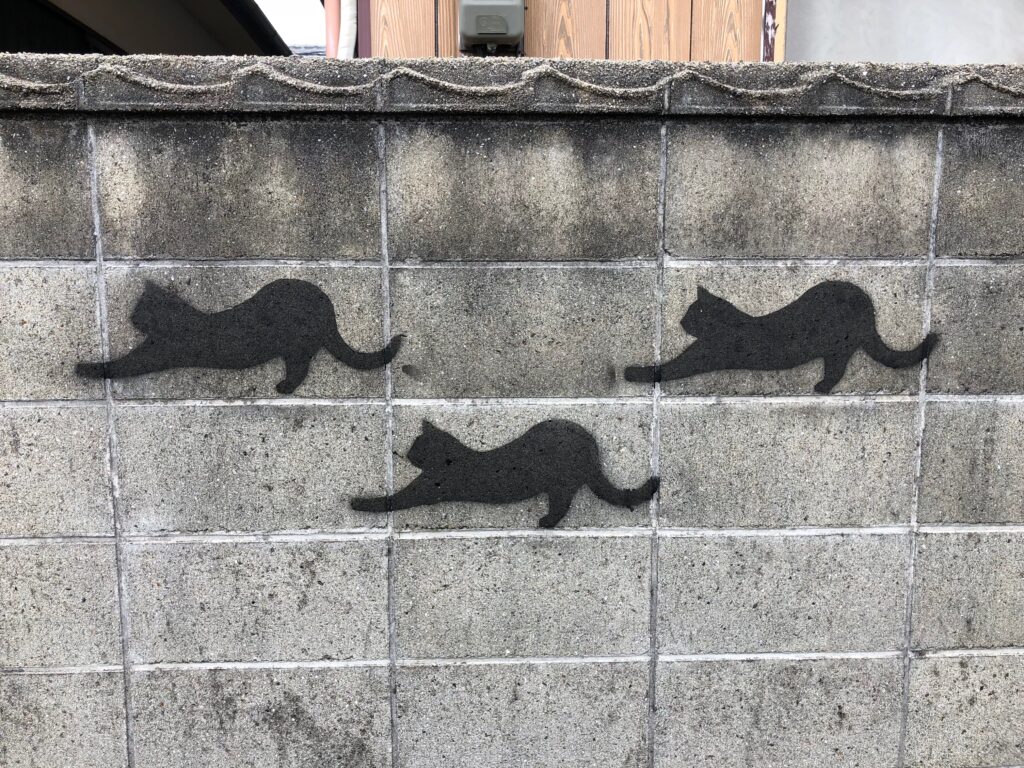
At the end of the street we found a block wall with silhouettes of black cats on it. I love this idea!
The Honmura Port area is not very large and can be explored in about 20 minutes. If you take your time to walk around, you will come across many lovely spots to take photos.
Terminal at the Port of Honmura
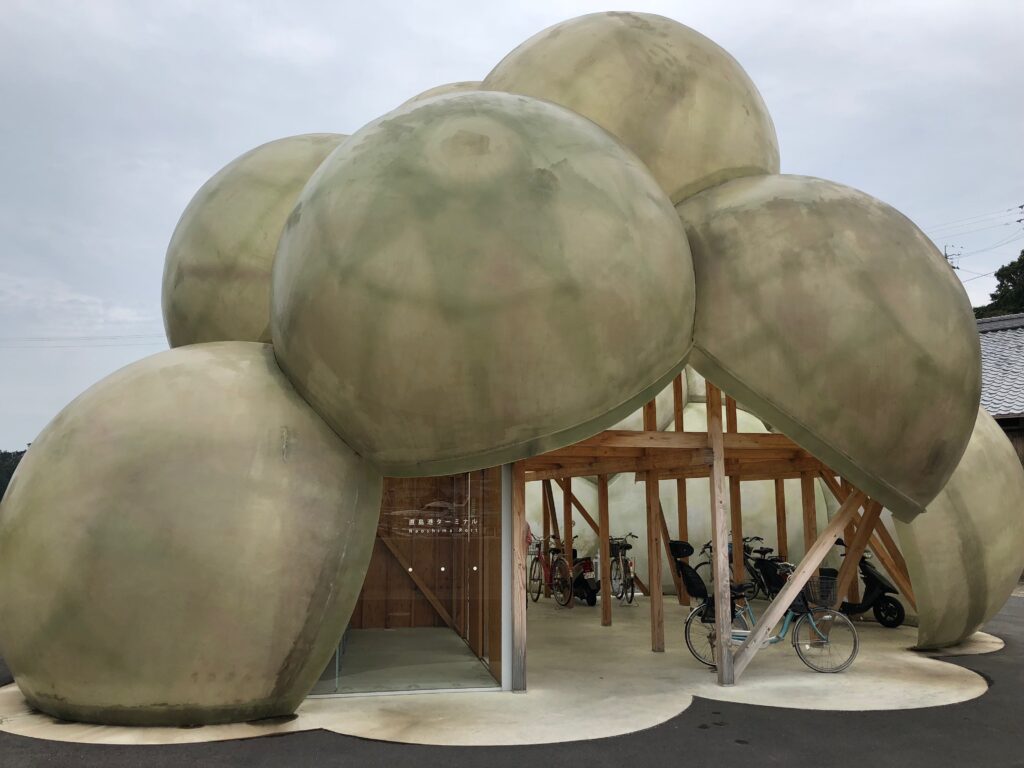
This cocoon dome is the waiting terminal for boats arriving and departing from the Port of Honmura.
While I was taking photos in front of this cocoon-shaped dome, another tourist asked me where is the Port of Honmura.
Indeed, at first glance it is difficult to recognise this as a port terminal. However, if there was a big sign, the atmosphere would be reduced by half.
As it was a Monday, almost all of the facilities in the Honmura area were closed, but there was one café near the harbour called “Naoshima Cafe Konnichiwa” which served curry and risotto.
After exploring the Kimura area, I went down to the nearby beach.
This is a video of me taking a closer look at the beach.
And this is a video of the whole beach.
The weather was not so good, but I think you can see how beautiful the beach is. I would have liked to keep looking at this clear sea, but it was getting close to time to catch the bus.
From the museum area to Miyaura Port (1 to 2 hours)
Take a bus to Benesse Art Site (5 minutes)
We also took the town bus from Kimura area to the museum area.
Starting from the bus stop at Honmura Port and getting off at the last stop, Tsutsujiso, you will arrive at the entrance of Benesse Art Site.
Yellow pumpkin sculpture
As you pass through the stone torii gate in front of you, another of Yayoi Kusama’s works, a yellow pumpkin, comes into view on your right. The area was not too crowded and I was able to take as many photos as I wanted.
From the entrance to Benesse Art Site, it is a four kilometre walk back to Miyaura Port.
I left the yellow pumpkin and walked in the direction of Benesse House Museum.
Benesse House & Museum
Benesse House is a hotel built on the edge of the shallow sea.
It has a museum attached to it, which hotel guests can enter free of charge.
After admiring the sculptures on the lawn in front of the hotel’s museum shop, I sat on the veranda in front of the terrace restaurant and rested for a while.
At this point so far, I have not seen any group of more than 10 people. Apart from me, there were only a few groups on bicycles, or individuals or pairs of tourists.
Open-air sculptures and the pier for guests
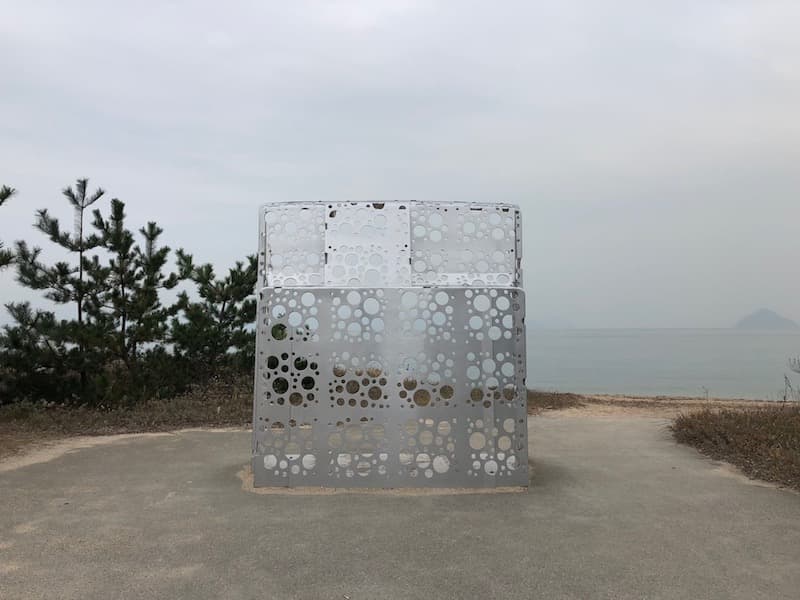
After a while I resumed my walk and arrived again at a place where some outdoor artworks were displayed.
The work above is ‘Shipyard Works: Stern and Hole’ by Shinro Ohtake.
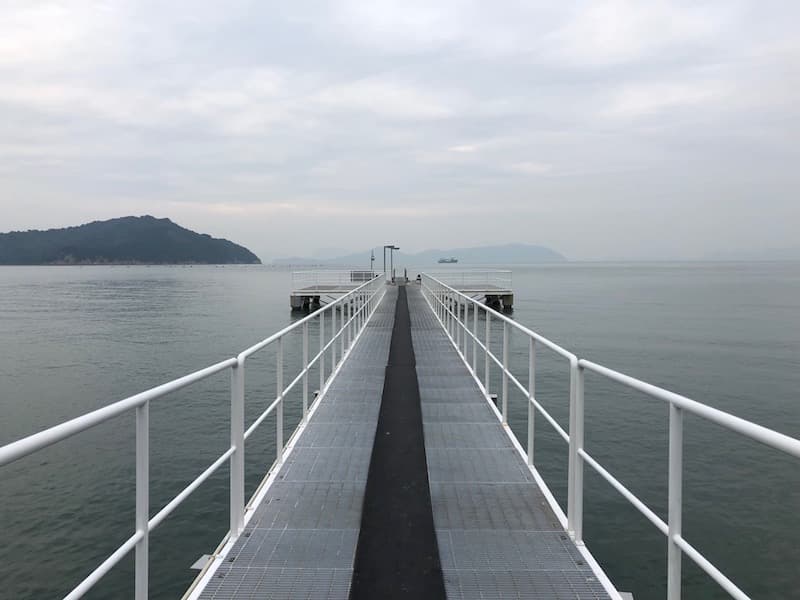
This is the pier for the guests of Benesse House. With the sea view as a backdrop, it is like a work of art.
Lee Ufan Museum
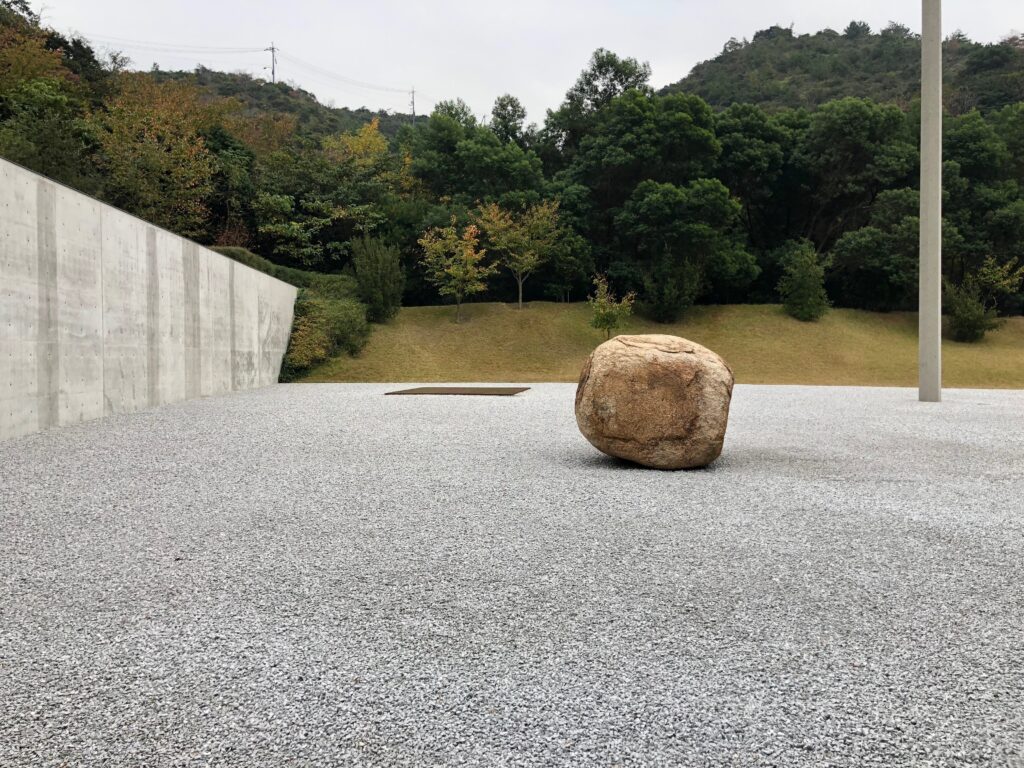
Passing by the Benesse House Museum, I walked with my back to the beach and passed by the Lee Ufan Museum.
The Lee Ufan Museum is dedicated to the work of Lee Ufan, a contemporary artist who creates mono-ha style works. His works, made of stone and steel plates, combine well with the concrete building designed by Tadao Ando.
Chichu Art Museum
This is the main entrance to the Chichu Art Museum. The Chichu Art Museum is where you can see Monet’s Water Lilies. The Chichu Art Museum is now open by appointment only and visitors cannot enter the museum on the day of their visit.
The building of the Chichu Art Museum was also designed by one of Japan’s most famous architects, Tadao Ando. Before I came to Naoshima, I had the impression that Naoshima was an island where Yayoi Kusama’s artworks were exhibited, but when I actually came here, I found out that Naoshima is also a place where you can enjoy Tadao Ando’s architecture.
Perhaps it was because I was mainly walking around the island this time and had only seen the buildings, that I felt this way even more.
As we passed the Chichu Art Museum, a small garden resembling a water lily pond appeared along the road. There was a flower bed around the pond with many lovely flowers.
Return to the port of Miyaura
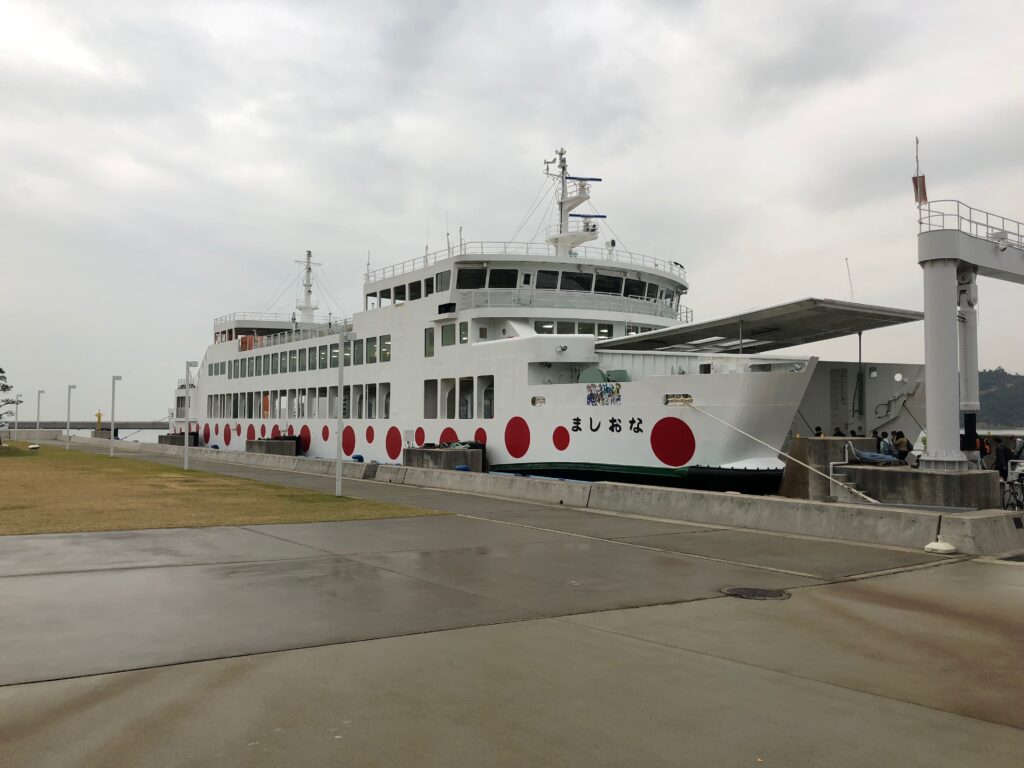
After passing the museum area and walking along the seafront for a while, the Naoshima Pavilions appear in front of you. I am back at Miyaura Port where I started.
It took me about four and a half hours in total to visit Naoshima after leaving Uno Port in Okayama Prefecture in the morning.
On the way back, I took the red polka-dot ferry to Uno Port in Okayama Prefecture, and then went to the Setouchi Onsen Tamano-yu (hot spring) adjacent to Uno Port.
My impressions of Naoshima on foot and by bus
Here are my thoughts on visiting Naoshima on foot (and by bus).
Advantages of visiting Naoshima on foot and by bus
Low travel costs
The town-run bus service around the tourist area of Naoshima is inexpensive at 100 yen per ride. You can rent bicycles in Naoshima for a reasonable price, but you can save even more money by walking.
You can travel at your own pace and enjoy the nature and scenery of the island.
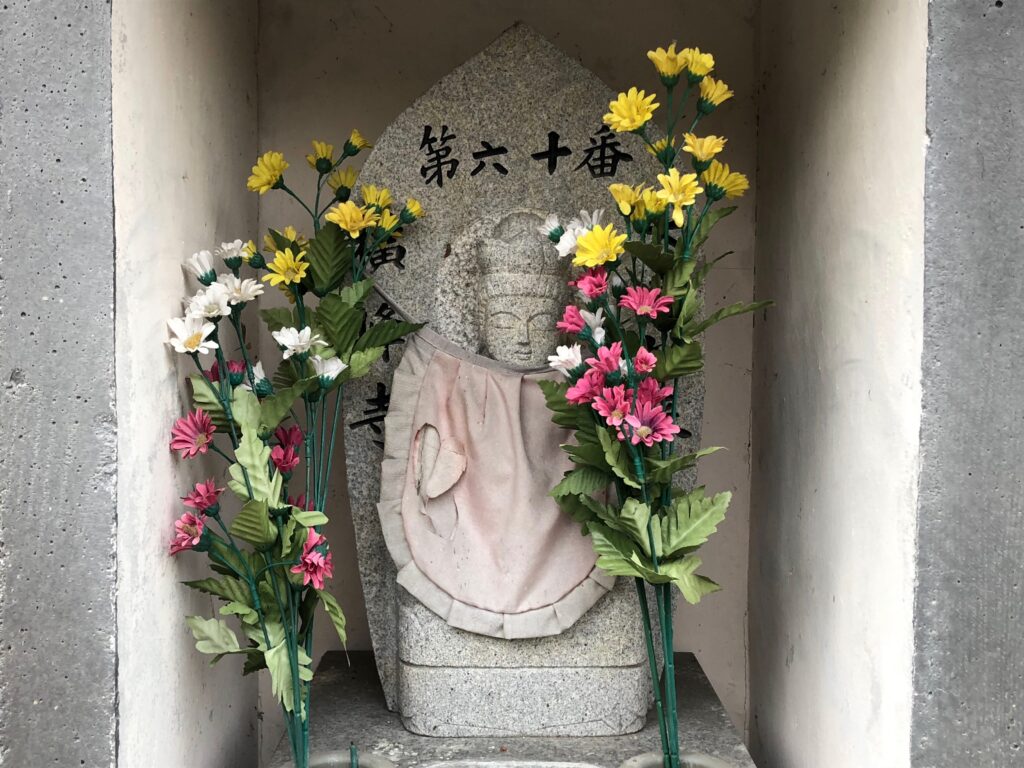
The advantage of travelling on foot in Naoshima is that you will not miss the small flowers and natural changes along the way that are difficult to notice by other means of transport.
Like the main island of Shikoku, Naoshima is home to 88 temples. Each temple has its own unique Jizo statue.
During our walk, I was able to pray to the Jizo-san for the safety of my journey.
Disadvantages of visiting Naoshima on foot
Time consuming and, depending on the season, strenuous
The disadvantage of walking is that it takes a long time.
It took me about an hour and a half to walk from the Tsutsujigasou stop to Miyaura Port, about 12,000 steps while looking at the artworks.
As it was an autumn day with light rain, it felt cool and comfortable. However, if the weather is too hot or too cold, you may feel exhausted.
Other ways to get around Naoshima
The museum area is served by Benesse’s shuttle bus service.
There is also a bicycle/bike rental shop on Naoshima. Bicycles without gearboxes can be rented for as little as 300 yen, which is a very reasonable price.
Summary of solo travel to Naoshima
A relaxing Monday trip is also recommended!
On Naoshima, I was able to experience a lot of artworks and beautiful natural scenery. The transportation on the island was well organized, and it was a place where you could enjoy a day trip.
On this trip, there were not many tourists, probably because many of the facilities and restaurants were closed, so I was able to relax.
Of course, if you visit on a day when the shops and establishments are open, you will get more out of your visit. However, if you feel like having the island to yourself, a trip on a Monday is a good idea.
Access to Marine Station Naoshima
| Access | 15 minutes by high-speed boat from Uno Port (20 minutes by ferry), 30 minutes by high-speed boat from Takamatsu Port (50 minutes by ferry) |
|---|---|
| Address | |
| URL | Official Website |
Sights in the area
The nearby islands of the Seto Inland Sea include Teshima and Shodoshima.

